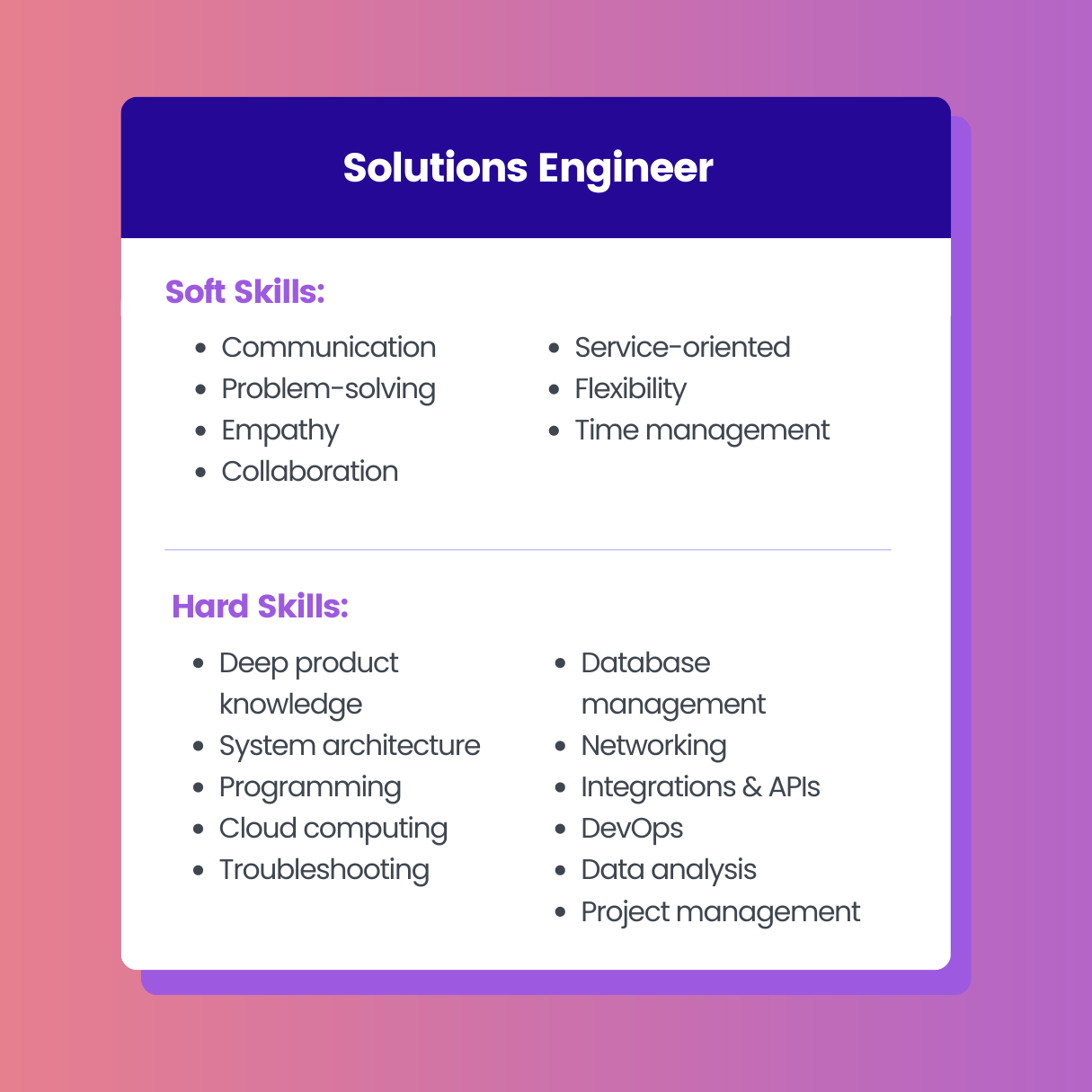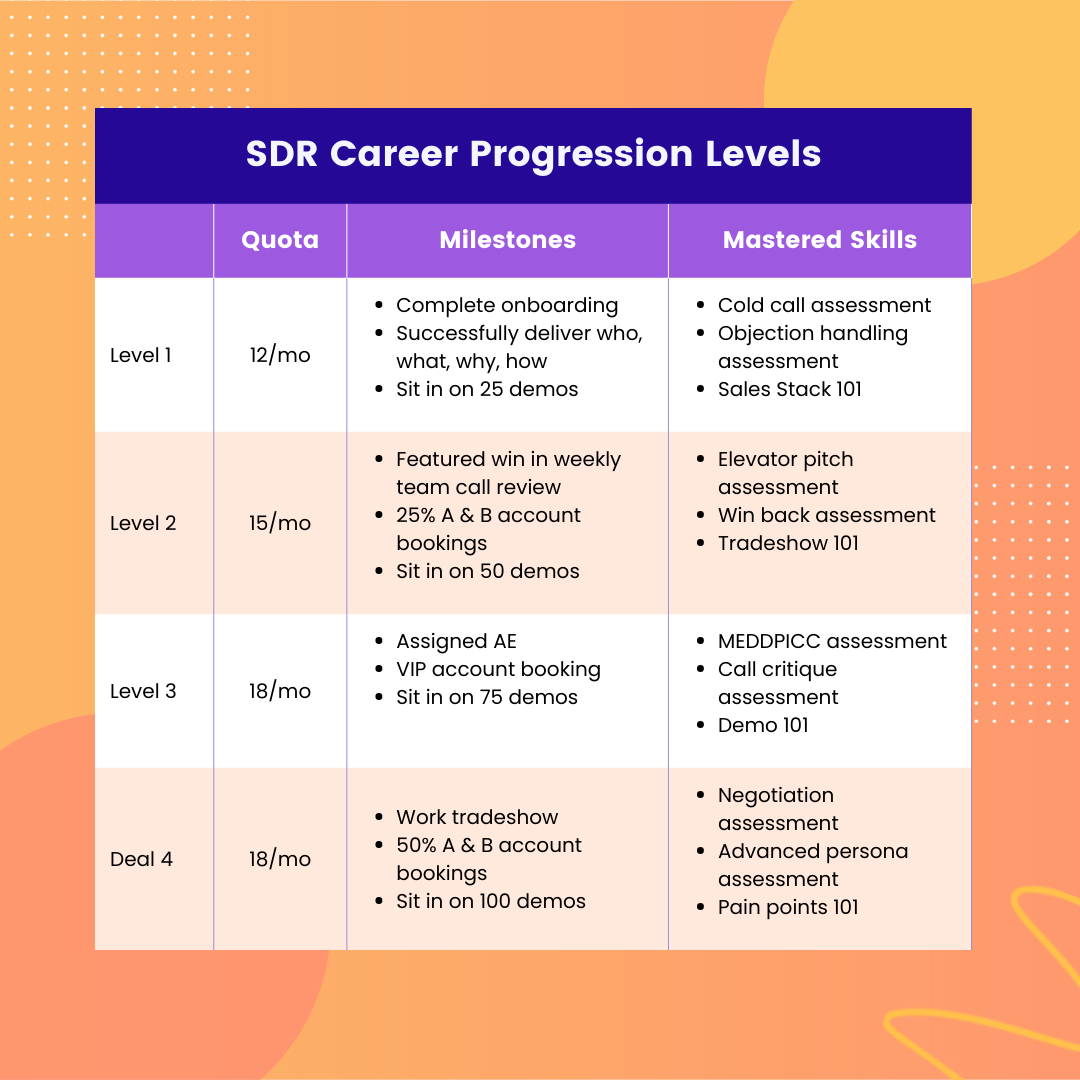The SDR, or Sales Development Rep, is undeniably the backbone of many successful sales organizations. SDRs play a vital role in building business, managing inbound inquiries, booking meetings, qualifying leads, and prospecting. However, the role of the SDR is often thankless. They face constant rejection, and their efforts can go overlooked and unappreciated.
Despite these hurdles, SDRs are a driving force behind sales growth and revenue generation. They’re expected to shake off the rejection, hold sales burnout at bay, and continue their cold calls and emails- all in an ongoing quest to get one more meeting, generate one more lead, or land one more opportunity. The role of an SDR is, in many ways, hustle culture personified.
So, how can you, as an SDR manager, ensure your team stays motivated, engaged, and productive in such a demanding and often thankless role? The answer lies in creating a rock-solid, scalable framework for SDR career progression.
In this blog post, we delve into the strategies and best practices for building an effective career path for your SDRs. Together, we will uncover actionable insights that will elevate your team’s performance and ensure they remain motivated and fulfilled throughout their journey. Let’s dive in!
4 Reasons Every SDR Manager Needs a Career Progression Strategy
A career progression strategy is no longer a “nice-to-have” within an SDR organization. Instead, it’s now a basic requirement for teams and organizations that seek rapid, sustainable growth. Here’s why:
SDR Retention & Engagement
52% of companies reveal that the average tenure within their SDR organization is less than a year (source). This statistic may initially sound alarming, but upon closer examination, it becomes evident why this is the case.
The role of an SDR is often considered a stepping stone towards other career goals, rather than a long-term destination. It’s a demanding and often thankless job, which contributes to the relatively short average tenure in the role. Employees often take on entry-level SDR roles and work diligently to prove themselves, with the hope that their efforts will eventually lead to new opportunities.
While other job functions experience similar challenges, the SDR role is unique in that the majority of SDRs enter with a specific end goal or timeline in mind. Unlike other job functions, where people frequently aim to have life long careers within a single role or concentration, the role of the SDR is often seen as a vehicle to other opportunities.
Given this context, it’s clear why formalizing a career progression strategy would have a significant impact on SDR retention and engagement. An SDR who has career conversations with their manager is aware of the timelines, skills, and next steps required to advance in their careers.
On the other hand, SDRs who aren’t having career conversations may seek opportunities elsewhere within organizations that can provide them with the next step up the career ladder or who offer a well-defined career progression plan.
Remember, the role of an SDR is seldom viewed as a lifelong career choice. Without a clear understanding of their future prospects within your organization, SDRs may experience burnout, a lack of motivation, and ultimately become more likely to consider leaving.
A well-designed career progression strategy acts as an insurance policy against these issues, ensuring that your SDR team remains motivated, engaged, and committed to achieving their goals.
Recommended reading: Pay Transparency: A Crucial Part of Your Recession Survival Kit
Recruiting Top Talent
Actively preparing and coaching your best employees to transition out of the SDR organization may initially seem counterintuitive. After all, if they’re performing well, wouldn’t you want to retain them in their current role?
Well, in many cases, the most successful SDRs are driven by the prospect of career progression. If this option isn’t available, two scenarios are likely: they lose motivation and their performance declines, or they start seeking opportunities elsewhere. In fact, 94% of employees surveyed said they would stay at a job longer if they were offered pathways for career development (source).
Recognizing that many SDRs enter the role with the goal of eventually moving on, having a defined career path or progression strategy is essential when it comes to retaining talented and motivated SDRs. Here’s why:
- Potential for growth: Highly motivated SDRs actively seek organizations that offer opportunities for career advancement. If they have a choice between a company with a clear SDR career path and one without, they are likely to favor the company with a defined progression strategy.
- Feeds both SDR and AE talent pool: Although not all SDRs move on to become Account Executives, the SDR to AE path is a fairly popular one. In fact, according to a recent poll we conducted, 53% of people who’ve held an SDR role reported they initially became an SDR as a stepping stone to becoming an AE. Although we’re generalizing a bit, great SDRs often make great AEs. Therefore, solidifying a career progression strategy not only nurtures the SDR talent pipeline but also fuels the AE talent pool.
- Showcases company culture: A well-developed career progression strategy reflects the organization’s commitment to professional development and investment in its employees. It sends a positive message to potential candidates about the company’s values and long-term outlook.
When hiring talented SDRs, consider this: it’s better to be the organization that SDRs aspire to leave a dead-end SDR role for, rather than the organization that loses SDRs due to the lack of a clear path for their most talented team members. Embracing a career progression strategy enhances your company’s appeal and ensures you retain your top-performing SDRs for the long term.
Recommended reading: How to Run a More Diverse and Inclusive Hiring Process
Resource Planning
When it comes to big picture planning, sales leadership and RevOps teams must have a deep understanding of metrics like team size and employee turnover rate. These numbers drive the sales capacity planning process, where teams work backward from revenue goals to ensure sufficient manpower for achieving future targets.
When an SDR team lacks a clear and repeatable process for career advancement, predicting growth and budgeting for resources becomes challenging. And, steady sales turnover, constant new hires, and performance issues arise due to the absence of career growth opportunities, amplifying unpredictability.
However, with a standardized framework for career coaching and advancement, SDR teams can easily forecast team size and plan for future resources.
Recommended reading: 23 Quotes to Guide Your Sales Compensation Planning Process
Performance Management
As we’ve alluded to several times throughout this post, the possibility of SDR career progression can make or break the motivation and performance of your team.
Managers that facilitate clear, concrete next steps, performance recommendations, and coaching conversations are providing their teams with both the proof of and motivation to strive toward the ultimate goal of career progression.
On the other hand, managers who make empty promises, provide limited and vague next steps, or who don’t welcome conversations about career progression, will find it increasingly difficult to motivate their teams and hit the targets set before them.
Career progression serves as a symbolic carrot, motivating SDRs to hit performance targets and timelines provided by their managers. As long as this goal is clear, SDRs remain driven.
Without a clear path forward or actionable items, motivation and drive quickly diminish.
Recommended reading: The Ultimate Sales Checklist to Improve Performance
What are the different paths an SDR can take when they are ready to take the next step in their career?
There is no one-size-fits all approach when it comes to developing a career path for your SDR team. What works for one SDR might not work for another. For this reason, it’s important to understand and define the different options available within your organization before you even attempt to document your career progression strategy.
Here are a few of the most common paths SDRs may take, but depending on your business model, your industry, or your product, you may not have all of these positions or, there may be others you’d add to the list. For the sake of this conversation, we want you to use this section for inspiration and not as the end all be all.
Account Executive: As the most popular next step in an SDR’s sales career, an Account Executive is responsible for building and maintaining relationships with clients to drive sales and achieve revenue targets. They identify potential customers, present product or service offerings, negotiate contracts, and ensure customer satisfaction. The sales role involves closing deals and meeting sales objectives through effective communication and understanding prospect and customer needs.
Account Management: An Account Manager is responsible for nurturing and managing relationships with existing clients to ensure their satisfaction and maximize revenue opportunities. They act as the main point of contact for clients, addressing their needs, resolving issues, and upselling additional products or services. The role involves proactive client engagement, retention strategies, and collaborating with various internal teams to deliver exceptional customer experiences.
Customer Support: A Customer Support Representative or Customer Success Manager is responsible for providing assistance and resolving inquiries from customers regarding products or services. They handle various forms of communication, such as phone calls, emails, or live chat, to ensure timely and satisfactory resolutions to customer issues. The role involves active listening, problem-solving, and delivering exceptional customer service to enhance customer satisfaction and loyalty.
Sales Operations: Sales Operations is responsible for streamlining and optimizing the sales processes and systems within an organization. They work to improve sales efficiency, data accuracy, and overall performance by implementing and managing sales tools, analyzing data, and providing valuable insights to sales departments and leadership. The role involves supporting sales strategies, forecasting, and ensuring alignment between sales, marketing, and other departments to drive revenue growth and operational excellence.
Marketing: Depending on a person’s strengths or weaknesses there may be a path forward with a number of marketing roles. For example, an SDR who excelled at email writing and messaging might make a good copywriter. An SDR that’s great at trade show booths or in person meetings might make an excellent field marketer. Consult with your marketing team to get a feel for the roles on their team and what each of them involves.
Channel Sales: Channel Sales involves selling products or services through third-party partners or intermediaries rather than directly to end customers. The channel sales team works to build and maintain strong relationships with channel partners, such as distributors, resellers, or retailers, to expand market reach and drive sales. They collaborate with partners to promote and distribute products, negotiate contracts, and provide support, ultimately maximizing sales opportunities and revenue for the organization.
Solutions Engineer: A Sales Engineer or Solutions Engineer is responsible for bridging the gap between sales and technical teams. They work closely with sales representatives to understand customer needs and propose tailored technical solutions. The role involves presenting product demonstrations, addressing technical inquiries, and providing expert guidance to ensure the successful integration and implementation of products or services for customers.
SDR or Sales Manager: The SDR Manager oversees and guides the SDR team. They are responsible for setting goals, providing training and coaching, and ensuring the team meets its performance targets. The manager role involves strategic planning, performance analysis, and fostering a motivated and productive SDR team.
Recommended reading: How to Motivate Employees in Tough Times
Best practices for developing an official SDR career track
Developing an official SDR career progression framework may require multiple iterations and adjustments. Different organizations may find unique approaches that suit their needs best. It’s a process of getting started, rolling out initiatives, seeking feedback, and making refinements until a successful framework is established.
To help you get started, we’ve provided some commonly accepted best practices for creating an official SDR career track. Let’s explore these together:
Clearly define the core competencies required of each potential career path.
In order to recommend a career path or foster the skill set required of any potential role, you must first understand and document the core competencies of each. We recommend speaking to department heads, coworkers who currently hold the role in question, and doing research online to understand what qualities and skills a person must possess to do each.
Then, combine all of the feedback and research in one, easy-to-access, place that your entire team has access to. Do this for each potential pathway an SDR may choose to take. This approach ensures a comprehensive and clear understanding of the different career trajectories within the organization.
Here’s a quick example showcasing both soft skills– like time management– and hard skills– like programming:

Recommended reading: Skill vs. Will: When Skill Just Isn’t Enough in Sales
Clearly define the objectives and requirements an SDR must achieve before each career path becomes an option.
Establish clear performance requirements for career progression to ensure that advancement is a reward for top-performing SDRs, rather than something owed to all SDRs.
To achieve this, consider implementing a performance assessment scorecard using measurable criteria to establish tiers of performance. Then, determine the threshold that qualifies an individual to move beyond the SDR program. We recommend you document this system and make it readily available to the team for coaching, one-on-one discussions, self-assessments, and performance reviews.
While specific criteria will vary across companies and teams, remember that coaching should be continuous, and promotions should serve as rewards.
Here’s an example of what a scorecard like this might look like:

In this hypothetical tier system, to graduate out of the SDR role, team members must complete all Level 4 requirements and maintain quota attainment three quarters in row.
Recommended reading: 8 Better Ways to Re-engage Cold Prospects
Hold regular conversations with each individual about their progress and document what they need to do next in order to advance.
Regular career conversations with your SDRs are essential; waiting for performance issues or until a team member is dissatisfied is counterproductive.
During these discussions, assess where the SDR sees themselves within your tier system. Then, address any disparities between their self-assessment and your evaluation by citing specific skills they may lack. Offer specific examples and be clear about what it is they should be doing instead. Make sure they feel like they have the direction and resources to move forward.
Regular career conversations ensure SDRs are aware of their progress and have a clear path for growth at all times.
Recommended reading: 6 Red Flags that Might Mean Your Best Sales Rep is About to Quit
Collaborate with other departments and functions to make sure they understand and support your career progression framework.
After creating the basic framework and documentation, gaining buy-in from other departments and stakeholders is crucial for the success of this program. Ensure alignment among all leadership for effective implementation.
This might involve collaborating with each department to design a handoff or assessment process once an SDR meets requirements and expresses interest in a specific career path. Or, certain departments may want to introduce specialized training or transitional periods to prepare SDRs for the next step in their career progression.
Whatever this process looks like within your organization, open communication with department leaders is paramount, especially if this is a new program or initiative within the company. Expect iterations and adjustments as you refine the process to suit your organization’s unique needs.
Recommended reading: The Definitive Guide to Recession Proofing Your Sales Organization
Communicate early and often.
When implementing an SDR career progression program, prioritize open communication with your team. Ensure they grasp the goals and benefits of the initiative and address any inquiries they may have. Emphasize that the program is an evolving process and that you value their feedback throughout its implementation.
Demonstrating genuine concern for their well-being and involvement will foster a collaborative and supportive environment for the program’s success.
Recommended reading: Building Your First SDR Commission Plan
Final Thoughts
Remember, there is no one-size-fits-all approach, and the process may require iterations and adjustments. However, investing in a robust career progression strategy will not only benefit your SDR team but also contribute to the long-term success of your sales organization.
As SDRs continue their relentless pursuit of sales growth and revenue generation, a solid career progression strategy provides them with the motivation, guidance, and support they need to thrive in this demanding role. By embracing this approach, SDR managers can ensure their teams stay engaged, fulfilled, and on the path to success.
Recommended reading: Unpacking Gender Bias and Pay Disparity in Sales [Infographic]
About Spiff
Spiff is a new class of commission software that combines the familiarity and ease-of-use of a spreadsheet with the power of automation at scale- enabling finance and sales operations teams to self-manage complex incentive compensation plans with ease. Spiff is designed to facilitate trust across organizations, motivate sales teams, increase visibility into performance and earnings, and ultimately, drive top line growth. The platform’s intuitive UI, in-depth reporting capabilities, and seamless integrations make it the first choice among high-growth and enterprise organizations.






